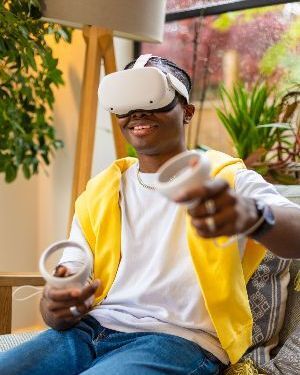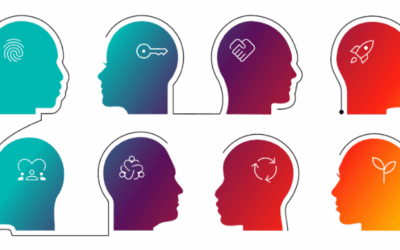Enhancing Online Learning with Virtual Reality: Introducing Nathan O’Grady
Nathan O’Grady, a leading expert in VR, AR, and E-Sports at King’s InterHigh, is at the forefront of using virtual reality to enrich our students’ learning experiences.
Virtual reality (VR) provides our students with profound educational opportunities right from their desks by recreating science labs, historical sites, and more. Additionally, Nathan is fostering community spirit and encouraging student participation through the establishment of our school’s first e-sports team.
We spoke with Nathan about driving educational innovation with technology and what the future holds. As he demonstrates, educational technology like VR is not a mere gimmick. Instead, it is a valuable tool that empowers teachers to bring learning to life and enables students to achieve their educational objectives.
Nathan’s journey into the world of technology began at the age of six when his father, an IT technician, taught him how to build computers. After studying Geography at university, Nathan pursued a career as an IT technician and later became interested in teaching. However, his curiosity went a step further: how could technology be harnessed to advance education?
Nathan became a teacher of Humanities and later Computer Science before joining King’s InterHigh—a perfect fit for a school that shares his commitment to innovation. Once settled into life at our online school, Nathan was quick to begin exploring the use of technology in education alongside a colleague, with virtual reality emerging as the latest educational development at King’s InterHigh.
Through extensive research, testing, and curation, Nathan and his team at King’s InterHigh have successfully implemented virtual reality in delivering the International Baccalaureate Diploma Programme (IBDP) for the first time. But their achievements don’t stop there.
“We have VR playgrounds for younger students, and we are exploring ways to connect groups of schools worldwide and bring students together,” Nathan shares.
Enhancing Learning
For Nathan, VR in education goes beyond engagement—it facilitates online learning activities and enhances them beyond what is typically possible.
Unlike traditional schools, online schools lack physical facilities such as science labs. Teachers at King’s InterHigh have long guided students through various STEM projects that can be conducted at home; until recently, the question remained how our students could participate in more complex laboratory experiences.
This is where virtual reality comes into play. With VR, students can engage in science experiments throughout the year without the need for a physical lab, visit museums without leaving their desks, and much more. Regardless of their location, students can access these experiences anytime and anywhere.
Furthermore, VR enables the creation of educational experiences that were previously unimaginable. Why watch a video of a volcano erupting when you can stand inside it and witness its inner workings? Why read about an underwater reef when you can explore its flora and fauna first-hand through a VR headset? Nathan affirms that virtual reality “adds value that goes beyond what has ever been possible before.”
As an example, Nathan shares the profound experience of a student who explored a VR recreation of the annex where Anne Frank hid during World War II. The virtual annex featured narrative commentary using excerpts from Anne Frank’s diary and other sound effects, providing an immersive experience for students.
The students who tested this VR experience had limited knowledge of Anne Frank beforehand. However, after removing their headsets, they retained a wealth of knowledge and understanding. They even described the annex as “claustrophobic,” demonstrating that virtual reality can deliver a true sensory experience without the need for physical travel.
In addition to history, Nathan and his team have tested virtual reality experiences across subjects such as English, Math, Sciences, and Humanities, with remarkable results in terms of comprehension and mastery.
While virtual reality is just one of many teaching tools at King’s InterHigh and not used in every lesson, it greatly enhances learning when applied correctly. For instance, in a maths lesson, students who previously struggled with geometry found it easier to grasp three-dimensional shapes when interacting with them in a VR space.
According to Nathan, this research was a turning point for teachers at King’s InterHigh and an exciting development for students. Learning through VR was not only engaging but also highly valuable in terms of learning outcomes. Nathan explains, “They could feel things and experience them in ways they had never encountered before in learning. This gave us a lot of confidence.”

Nathan O’Grady
Overcoming Scepticism
Nathan acknowledges that convincing others about the merits of VR is often the most challenging part. “It usually starts with a conversation, which is not the easiest way to sell this technology,” he explains. However, once you place a VR headset directly on someone’s head, the experience becomes far more persuasive than mere descriptions. Nathan says, “Once the environment is in front of you, and you can see the scale, hear it, and feel it, it’s a whole different experience. From there, I think the technology proves itself.”
Another obstacle is helping educators become familiar with the tools and empowering them to create their own VR learning experiences. It requires time and practice, but at King’s InterHigh, the adoption of virtual reality has been substantial. Nathan is always available to assist teachers as they gradually integrate VR education in a controlled and consistent manner.
Nathan believes that in the long run, VR in education will continue to grow. For now, he enjoys introducing people to VR for the first time and witnessing their discovery of its immense potential. He asserts, “You don’t need to do anything more than that. They see the value. They look at the lessons that have been created, walk around the virtual spaces, and witness their manifestation. And they say, ‘Okay, I get it.’
“Looking ahead, Nathan envisions a future where VR visuals match the clarity of television screens. He also anticipates the involvement of all senses—feeling, hearing, and smelling—in virtual reality experiences. While he acknowledges this as a bold vision rather than a prediction, he believes that VR will truly fulfil its potential when it provides a multi-sensory experience.
In conclusion, for Nathan, innovation means driving progress with a purpose. At King’s InterHigh, this entails pushing the boundaries of education. Virtual reality has the potential to deeply engage students, facilitate more diverse online learning experiences, and enhance knowledge and understanding. As long as it benefits both teachers and students and serves a purpose, Nathan believes these are the most critical factors.
An Introduction to King’s InterHigh
Ashley Harrold, CEO of Inspired Online Schools in conversation with Fiona Murchie
Related reading from our sister website Relocate Global:

Join Think Global People
Our exclusive membership network for decision-makers, aspiring leaders, experts and thought leaders focused on global business and working.





